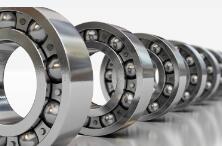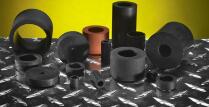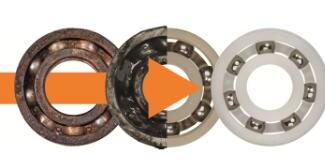Ball Bearing Materials: The Definitive Guide (2023)
Learn all about ball bearing materials in this comprehensive guide! Discover the advantages and disadvantages of each material, and see which one works best for your project.
With the growing demand for efficient and reliable ball bearings, selecting the right material is key to successful performance.
This guide provides an in-depth look at the different materials used in ball bearings and how to choose the right one for your application.
Ball bearings are typically made from stainless steel, carbon steel, or ceramic.
Each material offers unique benefits, such as low friction, noise reduction, and high-temperature resistance.
Careful selection of the right material is essential to ensure optimal performance.
This guide covers the materials used in their manufacture, from steel to ceramic and plastics.
Learn the advantages and disadvantages of different materials, as well as best practices for installation and maintenance.
Find out why the right material choice can make a big difference!
Ball Bearings Introduction

Ball bearings are a type of mechanical bearing that use balls to reduce friction between two surfaces.
Ball bearings are used to provide smooth, low-friction motion in rotary applications, and can also be used to support radial and axial loads.
Ball bearings are available in both radial and thrust configurations, and are used in a variety of applications, including but not limited to automotive, aerospace, and medical.
Ball bearings are designed to provide maximum performance with minimal maintenance and can be used in both dry and wet environments.
Bearing material types

1.Carbon Steel Bearings
Carbon steel bearings are a type of bearing that is made out of carbon steel and are used in various applications.
These bearings are highly resistant to wear, corrosion, and shock and are also highly durable.
They are also relatively economical, making them a popular choice for many uses.
2.Chrome Steel Bearings
These bearings are typically made from chrome-alloy steel and feature hard chrome plating.
This makes them resistant to wear and corrosion, allowing them to last a long time in demanding environments.
3.Stainless Steel Bearings
Stainless steel bearings are a popular choice for applications in corrosive environments due to their superior corrosion resistance.
Since stainless steel bearings have such a long lifespan and their corrosion resistance is so great, they are often used in food processing and medical equipment, as well as other industrial applications.
4.Ceramic Bearings
Bearings made of ceramic are very useful in high-speed and high-temperature applications.
They can tolerate temperatures up to 450°C, making them ideal for high-speed applications such as turbo machinery and electric motors.
5.Polymer Plastic Bearings
Bearings made of polymer plastic are a great alternative to traditional metal bearings.
They are lightweight and resistant to corrosion, making them perfect for use in wet and corrosive environments, such as in marine and food processing applications.
Polymer plastic bearings also have low friction, helping to reduce energy consumption.
6.Hybrid Bearings
Hybrid bearings are a type of bearing that combines the best of both worlds—steel and ceramic components.
They are made of steel rings that contain ceramic balls.
The steel rings are very durable and have a longer life than traditional bearings while the ceramic balls provide higher speeds and less friction than steel balls.
Ball material types
steel ball
Roller bearing steel 1.3505/100Cr6
Roller bearing steel 1.3505/100Cr6 is a high carbon, high chromium martensitic stainless steel with an excellent balance of hardness and wear resistance.
It is known for its excellent corrosion resistance and low-temperature toughness.
The steel can be heat treated to achieve a wide range of properties.
The steel balls made from 1.3505/100Cr6 are used in precision bearings, as well as a variety of other applications such as automotive, aerospace, military, medical, and industrial applications.
The balls are typically manufactured to a tight tolerance of +0/-0.02mm, and they are suitable for applications requiring high hardness, wear resistance, and corrosion resistance.
plastic ball
Stainless steel 1.4401 and 14401 (SS316L)
Stainless steel 1.4401 (also known as SS316L) is a type of austenitic stainless steel that contains a higher level of molybdenum and lower levels of carbon and nitrogen than the standard grade of stainless steel.
This type of stainless steel is often used in the production of medical devices, consumer products, and food processing equipment due to its superior corrosion resistance and formability.
When used in the production of plastic balls, stainless steel 1.4401 provides superior durability and resistance to wear, as well as excellent thermal conductivity and tensile strength.
The plastic ball can also be machined into intricate shapes and sizes, making it suitable for many different applications.
Soda-lime glass
Soda-lime glass is a type of glass that is composed of about 70% silica, with the remainder consisting of sodium oxide, calcium oxide, and other oxides.
It is a very common type of glass and is used in a variety of applications, including the production of plastic balls.
The glass has good optical clarity, is strong, and is relatively easy to shape. The glass is also resistant to thermal shock and has good chemical durability.
It is also very cost-effective, making it a popular choice for many plastic ball manufacturers.
Borosilicate glass
Borosilicate glass is a type of glass that is composed of approximately 80% silica and 12% boric oxide, making it highly heat resistant.
Borosilicate glass is also known for its low thermal expansion coefficient and high resistance to thermal shock.
A plastic ball made of Borosilicate glass is designed to withstand high temperatures and resist thermal shock.
Glass has a very low coefficient of thermal expansion, which makes it a great material for making plastic balls.
Borosilicate glass is also resistant to corrosion, making it an ideal material for making plastic balls that need to be used in corrosive environments.
The glass also has excellent optical clarity, making it a great material for making plastic balls that need to have a clear view.
ceramic ball
Aluminium oxide Al2O3
Aluminum oxide Al2O3 in a ceramic ball has a very high melting point (2050°C), making it a great choice for applications requiring wear and heat resistance.
Its hardness makes it useful for grinding and polishing applications. Its strong chemical bond makes it ideal for use as a catalyst.
It is also non-porous, which means it can be used to coat surfaces that need to be waterproof or resistant to corrosive materials.
The ceramic ball also has a very low thermal conductivity, making it an excellent insulator.
Silicon nitride Si3N4
Silicon nitride (Si3N4) is a ceramic material that is strong, lightweight, and highly resistant to wear and corrosion.
It is typically used in the production of ceramic bearings and other components in a wide range of industries, including automotive, aerospace, and medical.
Silicon nitride is composed of two parts: silicon (Si) and nitrogen (N). The material consists of alternating layers of Si and N atoms that are bonded together in a crystalline structure.
This structure gives silicon nitride its superior strength and low density, making it an ideal choice for components that require high load-bearing capacity and low weight.
Cage material types
Steel cages
Steel cages of ball bearings are typically made from cold-rolled steel, which is hardened for strength and durability.
The steel cages are made with a rounded or flat outer surface that allows the balls to roll freely.
The interior of the cage is designed with a series of round or oval openings that hold the balls in place and provide the necessary spacing for lubrication.
Brass cages
Brass cages of ball bearings are typically made of a high-grade brass alloy, such as C83600, C86300, or C93700.
These alloys provide excellent corrosion resistance, high strength, and thermal conductivity.
The cage is usually machined from a solid piece of brass and may have an additional heat treatment process to increase its strength and wear resistance.
The cage is designed to provide a low-friction, non-stick surface for the rolling elements and to protect the bearing from contaminants.
The inner and outer races of the bearing are typically designed to fit into the cage, which helps to maintain the correct internal alignment and reduce vibration.
The cage may also feature lubrication grooves or holes to allow for the introduction of grease during installation.
Polymer cages
Polymer cages of ball bearings typically have a rectangular or circular shape, with a hollow interior space to house the balls.
The sides of the cage are made from a strong, lightweight polymer material such as polyamide or polypropylene.
The cages may also have a small number of holes or slots to allow the balls to move freely.
The cages are designed to protect the bearings from dirt and debris while allowing them to spin freely.
Most polymer cages are designed to fit standard-size bearings, but custom designs are also available.
Conclusion
Ball bearings are a vital component of many moving parts and machines. With the right material, they can be used in a wide range of applications.
This guide has aimed to provide readers with an overview of the different materials available and what to consider when choosing the right one for their project.
With this knowledge, users can make an informed decision to ensure their ball bearing performs as expected.






